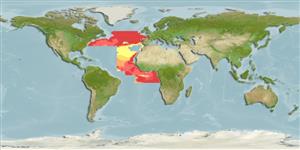>
Alepocephaliformes (Slickheads and tubeshoulders.) >
Alepocephalidae (Slickheads)
Etymology: Bathytroctes: Greek, bathys = deep + Greek, trokta, -on = sweets for dessert; also = troktos, -e, -on = edible (Ref. 45335).
Eponymy: ‘Michael Sars’ was the name of the Norwegian research vessel from which the holotypes were collected. The vessel was named after the Norwegian theologian and biologist Michael Sars (1805–1869). (Ref. 128868), visit book page.
Environment: milieu / climate zone / depth range / distribution range
Ökologie
seewasser bathypelagisch; tiefenbereich 2010 - 5057 m (Ref. 34286). Deep-water; 53°N - 9°S
Eastern Atlantic: southwest of Ireland and off Portugal; Cameroon south to Angola (Ref. 4460). Also known from the Northwest Atlantic.
Size / Gewicht / Alter
Maturity: Lm ? range ? - ? cm
Max length : 37.0 cm SL Männchen/unbestimmt; (Ref. 4460)
Life cycle and mating behavior
Geschlechtsreife | Fortpflanzung | Ablaichen | Eier | Fecundity | Larven
Sazonov, Y.I., 1999. On the revision of the genus Bathytroctes Günther (Alepocephalidae): a review of the abyssobenthopelagic forms (previously referred to the genus Nomoctes) with a description of two new species. J. Ichthyol. 39(9):699-712. (Ref. 34286)
IUCN Rote Liste Status (Ref. 130435: Version 2024-2)
Bedrohung für Menschen
Harmless
Nutzung durch Menschen
Fischereien: nicht kommerziell
Tools
Zusatzinformationen
Download XML
Internet Quellen
Estimates based on models
Preferred temperature (Ref.
123201): 2.6 - 3.3, mean 2.9 °C (based on 650 cells).
Phylogenetic diversity index (Ref.
82804): PD
50 = 0.5005 [Uniqueness, from 0.5 = low to 2.0 = high].
Bayesian length-weight: a=0.00347 (0.00163 - 0.00737), b=3.19 (3.00 - 3.38), in cm total length, based on LWR estimates for this (Sub)family-body shape (Ref.
93245).
Trophic level (Ref.
69278): 3.5 ±0.5 se; based on size and trophs of closest relatives
Widerstandsfähigkeit (Ref.
120179): mittel, Verdopplung der Population dauert 1,4 - 4,4 Jahre. (Preliminary K or Fecundity.).
Fishing Vulnerability (Ref.
59153): Moderate vulnerability (35 of 100).
